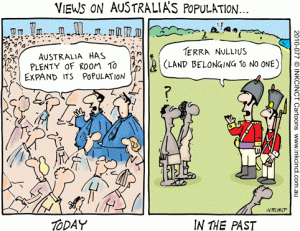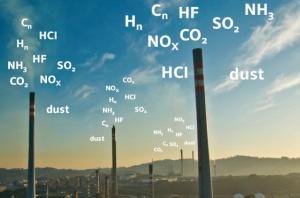
After dipping my foot into the murky waters of human population demography a few years ago, I’m a little surprised that I find myself here again. But this time I’m not examining what the future of the global human population might be and what it could mean for our environment; instead, I’m focussing on Australia’s population future and its implications for our greenhouse-gas emissions trajectories.
Just published in Asia and the Pacific Policy Forum1, my paper with long-time co-author Barry Brook is entitled Implications of Australia’s population policy for future greenhouse gas emissions targets. It deals with the sticky question of just how many people Australia can ‘afford’ to house. By ‘afford’ I mean several things, but most specifically in the context of this paper is by how much we need to reduce our per capita emissions to achieve future reduction targets under various immigration-rate scenarios.
In many ways Australia’s population is typical of other developed nations in that its intrinsic fertility (1.78 children/woman) is below replacement (which is itself ~ 2.1 children/female). Yet Australia’s population grew nearly twice (1.88×) as large from 1971 to 2014. It doesn’t take a genius to figure out that most of our population growth is due to net immigration.
In fact, between 2006 and 2014, Australia welcomed a net of 215,000 new people per year (this means that of all the permanent immigrants and emigrants, a ‘net’ of approximately 215,000 stayed each year), which represents about 1% of our total population size (that latter most likely just ticked over 24 million).

So Barry and I asked the question: under various future scenarios of likely and extreme net immigration scenarios, by how much will Australians have to reduce their per capita emission to achieve future reduction targets?
The first thing to do here is to identify the targets. Right now we have a target of 5% reduction on year 2000 emissions2 by 2020, and the recently established3 2030 target of 26-28% below year 2005 emissions (equivalent to a 21-23% reduction of year 2000 emissions). Prior to the current government, Labor had set a target of 80% reduction of 2000 emissions by 2050, but the Coalition promptly repealed that target upon gaining government in 2013. Nonetheless, we modelled what changes to per capita emissions would be required to meet all of these real (2020 & 2030) and supposed (2030) targets.
Next, we projected the Australian human population forward to 2100 under six different net immigration scenarios:
- Status quo net total immigration of 215,000 people/year (i.e., fixed amount).
- Status quo net proportional immigration of 1% of total population size/year.
- Double the net total immigration per year.
- Zero net immigration (effectively ‘closing Australia’s doors’).
- A total net immigration of 20,000 people/year.
- A total net immigration of 100,000 people/year.
Scenarios 3 and 4 are admittedly a little extreme, but we included them anyway to make a few points about population change.
From these scenarios, a few salient features emerge:
- As predicted, a net zero immigration sees Australia’s population ‘peak’ around 2040, and decline only slightly to 23.4 million by 2100.
- A net immigration of 20,000 people/year essentially stabilises the Australia population around 25-26 million.
- A constant (fixed) net immigration rate of 215,000 people/year leads to a population size in 2100 of 53 million.
- Keeping net immigration constant at 1% of total population size would end up with 87 million Australians by 2100.
But what does all this mean for our emissions? To simplify things, let’s just look at Scenarios 2 (1% net immigration) and 4 (zero net immigration). To reach our current commitment of 27% reduction (median) by 2030 under the COP21, we would have to reduce our per capita emissions by 1.6 (zero net immigration) to 2 times (1% net immigration). That’s in less than 14 years from now to get down to between 13 and 15 t CO2-e/year/person.
The more ‘extreme’ (i.e., necessary) target of an 80% reduction by 2050 would mean we’d have to reduce our per capita emissions by between 6.3 (zero net immigration) and 10.2 times (1% net immigration) to achieve emissions of around 3-5 t CO2-e/year/person in less than 34 years.
Yeah, right.
Of course, that’s just the domestic NGGI emissions2. It also conveniently ignores all the ancillary (potential) emissions we ship offshore in the form of (mostly) coal, oil and gas. In fact, Australia has linearly exported the equivalent of about 18 t CO2-e/year/person in 1990 to over 40 t CO2-e/year/person today, which now represents about 1.5-1.6 times our current domestic emissions! And we don’t even bloody count those!
If you study the environmental damage we’ve done to Australia over at least the last 200 years, one could make a solid argument that we have decidedly surpassed our long-term human carrying capacity long ago, such that any further increases in our population size will only exacerbate the damage, in addition to making climate change mitigation more difficult.
As it turns out, we’ll have to make whopping reductions in our per capita emissions regardless of our immigration policy, with Scenario 2-like futures (constant proportional net immigration) resulting in roughly 10% more emission than we would otherwise have if our population remained stable.
In short, we need a rapid energy revolution if we want any chance of stemming our emissions to meaningful rates.
Finally, I could not resist the temptation to tackle the furphy that is commonly spouted by our politicians and on the news that our ‘ageing population’ will spell economic disaster via runaway healthcare costs. Sorry – it’s complete bullshit.
First, there’s no evidence at all in Australia or elsewhere that a rising proportion of retirees blows out health care costs (see here, here and here). Secondly, the natural corollary of an aging population is that fewer children are also born. If you have children, you know how expensive they can be. The dependency ratio (number of ‘dependents’ [children & retirees] divided by the number of working people), and its economic variant, the dependency cost ratio (those numbers turned into child care, aged care and health care costs), are surprisingly invariant to even extreme population changes.
It’s therefore a myth that an aging population is a bad thing. If anything, we should be encouraging a stabilisation of our population.
—
1This is a new one for me.
2This only counts the so-called National Greenhouse Gas Inventory (NGGI) total, representing our Kyoto Protocol 2nd commitment. It (sneakily, in my view) ignores the emissions stemming from so-called Land Use, Land Use Change and Forestry (LULUCF).
3Under the 2015 Paris Convention of Parties 21 agreement.
CJA Bradshaw

